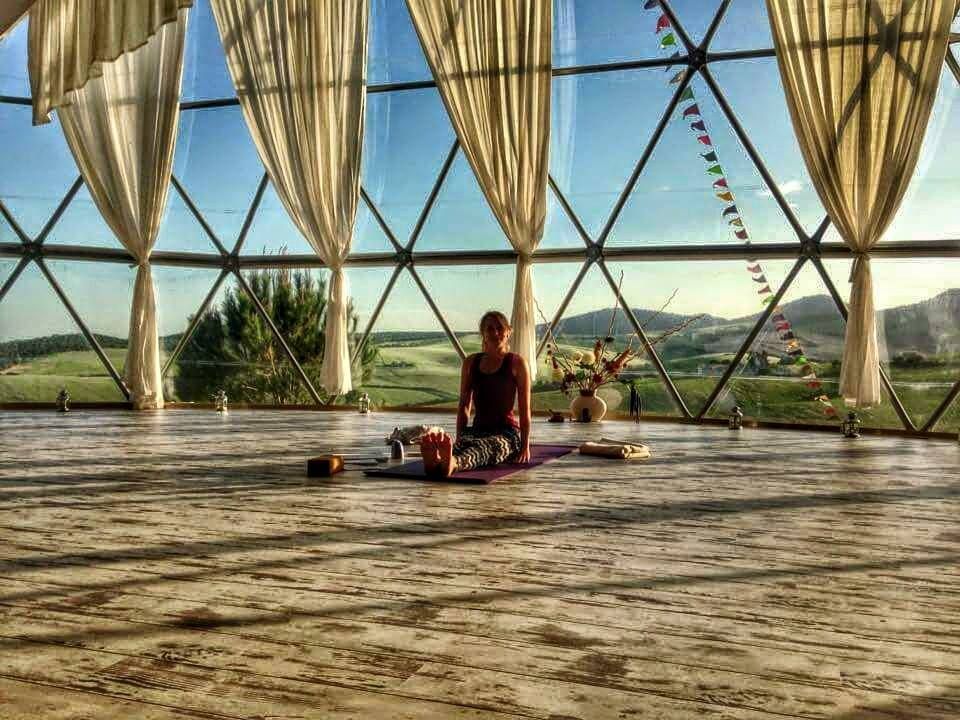I’ve spent the last 10 days in Guatemala for the first part of my 500 hour Advanced Yoga Teacher Training with Frog Lotus Yoga International. The experience has been incredible, not least because we’ve done an hour of meditation every morning followed by a 3 hour yoga workshop. This is what I’ve found…
My learning from doing yoga for 3 hours every day
- Much of what you can’t do is in your mind.
Being challenged to try new things, and to keep trying them is a really good thing. There have been many postures, like Astavakrasana (in the picture) that I’d not done before because I assumed I couldn’t do them. Life lesson there. It’s also tempting to give up when you can’t do something the first time you attempt it. But when you do try again, it’s surprising how quickly your body learns.
- Your body can also be the most frustrating thing.
That said, there are still plenty of postures that I feel like I “should” be able to do now after doing so much yoga, but my body isn’t ready for yet. Full Hanumanasana (splits) for example – I mean seriously, I’ve been practising every day for the last six months! But yoga tunes you into your body’s the innate intelligence and what that can teach you. Unfortunately, for certain things, the lessons are in patience and acceptance of where you are right now. It’s about trusting that with consistent practice the posture will come, when and if it serves you.
- Yoga tells you what you need and when.
On a similar note, unlike fitness training, where you might set specific goals, yoga has a tendency to dictate what your body needs next. This may or may not be the same as your ego’s ideas. I came to Guatemala thinking that I’d done enough strengthening work, and it was time to improve my flexibility. I probably have improved my flexibility a little, but what doing yoga for 3 hours every day here has really taught me is that I still need to get stronger. Much stronger. Because I’m naturally hypermobile, I have muscle groups that need strengthening before I develop a greater range of motion. Yoga won’t let me ignore that in the way that I could if I was training in the gym.
- Progress isn’t linear.
My first morning of practice here was amazing. My hips felt super-open, I managed dragonfly pose for the first time and everything came very naturally. I thought I’d nailed it. I had visions of myself levitating by the end of the week. The next day, everything hurt. My legs felt like they were made of stone. Even handstands, which I usually love, were a massive effort. You have to accept that even when you do yoga for 3 hours per day, not every day is a “breakthrough day”. Some days have been about practising gratitude and surrendering to the reality exactly as it shows up.
- Doing so much yoga feels amazing.
Before I came out to Guatemala, I’d been doing lot of other exercise as well as yoga, like spinning and interval training. I thought I’d miss that when I came to just doing yoga. I even told myself I might carry on some fitness training in my breaks. No chance. My short breaks are spent reading my course books while trying to catch a few rays of sunshine. But I’ve loved it. My body and mind feel really good for the consistency and routine of this daily practice.
Now I’ve just got to figure out how I can carve 3 hours out of every day to practise yoga when I leave here…


 I was at a gig the other night. Unusually cool for me, I know. I have my little brother to thank for that. Left to my own devices I’d have spent Saturday night eating tofu stir-fry and watching Strictly Come Dancing. Anyway, I was struck by the number of people who had their phones out filming it. Their whole view was reduced to the size of their phone screen. I could understand filming a little bit to share with friends, or to play back later, but the entire thing? Really? Is having a pale imitation of the gig to keep worth diminishing the actual experience of being there?
I was at a gig the other night. Unusually cool for me, I know. I have my little brother to thank for that. Left to my own devices I’d have spent Saturday night eating tofu stir-fry and watching Strictly Come Dancing. Anyway, I was struck by the number of people who had their phones out filming it. Their whole view was reduced to the size of their phone screen. I could understand filming a little bit to share with friends, or to play back later, but the entire thing? Really? Is having a pale imitation of the gig to keep worth diminishing the actual experience of being there? 









 While at Suryalila, I had the opportunity to teach my first ever yoga class. I say opportunity, but to be honest I had to be coaxed, bribed and coerced into taking the class. I was terrified. Because the thing about teaching yoga in a yoga retreat is, people know what you’re doing. And therefore they know when you don’t know what you’re doing.
While at Suryalila, I had the opportunity to teach my first ever yoga class. I say opportunity, but to be honest I had to be coaxed, bribed and coerced into taking the class. I was terrified. Because the thing about teaching yoga in a yoga retreat is, people know what you’re doing. And therefore they know when you don’t know what you’re doing.